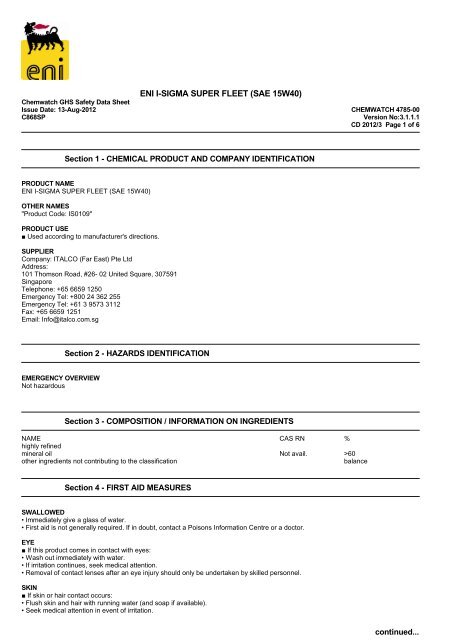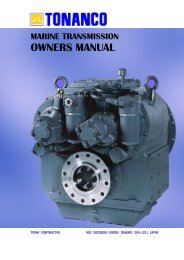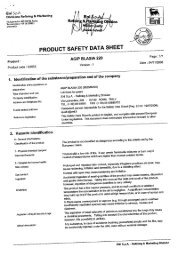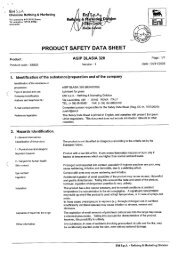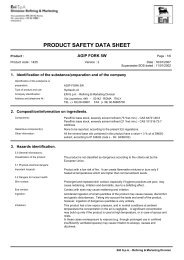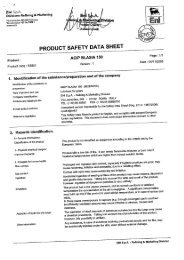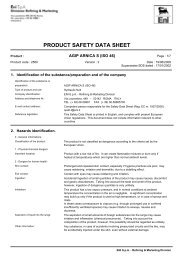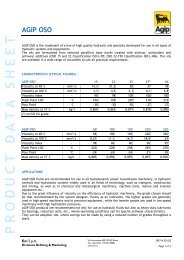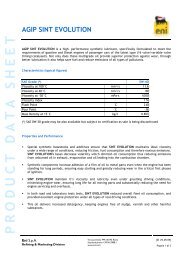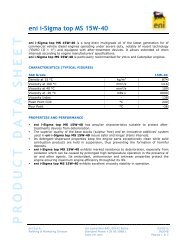eni i-sigma super fleet (sae 15w40) ghs sds 4785-00 - TransDiesel
eni i-sigma super fleet (sae 15w40) ghs sds 4785-00 - TransDiesel
eni i-sigma super fleet (sae 15w40) ghs sds 4785-00 - TransDiesel
You also want an ePaper? Increase the reach of your titles
YUMPU automatically turns print PDFs into web optimized ePapers that Google loves.
ENI I-SIGMA SUPER FLEET (SAE 15W40)<br />
Chemwatch GHS Safety Data Sheet<br />
Issue Date: 13-Aug-2012 CHEMWATCH <strong>4785</strong>-<strong>00</strong><br />
C868SP<br />
Version No:3.1.1.1<br />
CD 2012/3 Page 1 of 6<br />
Section 1 - CHEMICAL PRODUCT AND COMPANY IDENTIFICATION<br />
PRODUCT NAME<br />
ENI I-SIGMA SUPER FLEET (SAE 15W40)<br />
OTHER NAMES<br />
"Product Code: IS0109"<br />
PRODUCT USE<br />
■ Used according to manufacturer's directions.<br />
SUPPLIER<br />
Company: ITALCO (Far East) Pte Ltd<br />
Address:<br />
101 Thomson Road, #26- 02 United Square, 307591<br />
Singapore<br />
Telephone: +65 6659 1250<br />
Emergency Tel: +8<strong>00</strong> 24 362 255<br />
Emergency Tel: +61 3 9573 3112<br />
Fax: +65 6659 1251<br />
Email: Info@italco.com.sg<br />
Section 2 - HAZARDS IDENTIFICATION<br />
EMERGENCY OVERVIEW<br />
Not hazardous<br />
Section 3 - COMPOSITION / INFORMATION ON INGREDIENTS<br />
NAME CAS RN %<br />
highly refined<br />
mineral oil Not avail. >60<br />
other ingredients not contributing to the classification<br />
balance<br />
Section 4 - FIRST AID MEASURES<br />
SWALLOWED<br />
• Immediately give a glass of water.<br />
• First aid is not generally required. If in doubt, contact a Poisons Information Centre or a doctor.<br />
EYE<br />
■ If this product comes in contact with eyes:<br />
• Wash out immediately with water.<br />
• If irritation continues, seek medical attention.<br />
• Removal of contact lenses after an eye injury should only be undertaken by skilled personnel.<br />
SKIN<br />
■ If skin or hair contact occurs:<br />
• Flush skin and hair with running water (and soap if available).<br />
• Seek medical attention in event of irritation.<br />
continued...
ENI I-SIGMA SUPER FLEET (SAE 15W40)<br />
Chemwatch GHS Safety Data Sheet<br />
Issue Date: 13-Aug-2012 CHEMWATCH <strong>4785</strong>-<strong>00</strong><br />
C868SP<br />
Version No:3.1.1.1<br />
CD 2012/3 Page 2 of 6<br />
Section 4 - FIRST AID MEASURES<br />
INHALED<br />
• If fumes, aerosols or combustion products are inhaled remove from contaminated area.<br />
• Other measures are usually unnecessary.<br />
NOTES TO PHYSICIAN<br />
■ Treat symptomatically.<br />
• Heavy and persistent skin contamination over many years may lead to dysplastic changes. Pre-existing skin disorders may be<br />
aggravated by exposure to this product.<br />
• In general, emesis induction is unnecessary with high viscosity, low volatility products, i.e. most oils and greases.<br />
• High pressure accidental injection through the skin should be assessed for possible incision, irrigation and/or debridement.<br />
NOTE: Injuries may not seem serious at first, but within a few hours tissue may become swollen, discoloured and extremely painful<br />
with extensive subcutaneous necrosis.<br />
Section 5 - FIRE FIGHTING MEASURES<br />
EXTINGUISHING MEDIA<br />
• Foam.<br />
• Dry chemical powder.<br />
• BCF (where regulations permit).<br />
• Carbon dioxide.<br />
FIRE FIGHTING<br />
• Alert Fire Brigade and tell them location and nature of hazard.<br />
• Wear breathing apparatus plus protective gloves in the event of a fire.<br />
• Prevent, by any means available, spillage from entering drains or water courses.<br />
• Use fire fighting procedures suitable for surrounding area.<br />
FIRE/EXPLOSION HAZARD<br />
• Combustible.<br />
• Slight fire hazard when exposed to heat or flame.<br />
• Heating may cause expansion or decomposition leading to violent rupture of containers.<br />
• On combustion, may emit toxic fumes of carbon monoxide (CO).<br />
Combustion products include: carbon dioxide (CO2), phosphorus oxides (POx), metal oxides, other pyrolysis products typical of<br />
burning organic material.<br />
May emit poisonous fumes.<br />
CARE: Water in contact with hot liquid may cause foaming and a steam explosion with wide scattering of hot oil and possible<br />
severe burns. Foaming may cause overflow of containers and may result in possible fire.<br />
FIRE INCOMPATIBILITY<br />
• Avoid contamination with oxidising agents i.e. nitrates, oxidising acids, chlorine bleaches, pool chlorine etc. as ignition may<br />
result.<br />
Section 6 - ACCIDENTAL RELEASE MEASURES<br />
MINOR SPILLS<br />
■ Slippery when spilt.<br />
• Remove all ignition sources.<br />
• Clean up all spills immediately.<br />
• Avoid breathing vapours and contact with skin and eyes.<br />
• Control personal contact with the substance, by using protective equipment.<br />
MAJOR SPILLS<br />
■ Slippery when spilt.<br />
Moderate hazard.<br />
• Clear area of personnel and move upwind.<br />
• Alert Fire Brigade and tell them location and nature of hazard.<br />
• Wear breathing apparatus plus protective gloves.<br />
• Prevent, by any means available, spillage from entering drains or water course.<br />
Personal Protective Equipment advice is contained in Section 8 of the MSDS.<br />
continued...
ENI I-SIGMA SUPER FLEET (SAE 15W40)<br />
Chemwatch GHS Safety Data Sheet<br />
Issue Date: 13-Aug-2012 CHEMWATCH <strong>4785</strong>-<strong>00</strong><br />
C868SP<br />
Version No:3.1.1.1<br />
CD 2012/3 Page 3 of 6<br />
Section 7 - HANDLING AND STORAGE<br />
PROCEDURE FOR HANDLING<br />
• Avoid all personal contact, including inhalation.<br />
• Wear protective clothing when risk of exposure occurs.<br />
• Use in a well-ventilated area.<br />
• Prevent concentration in hollows and sumps.<br />
SUITABLE CONTAINER<br />
• Metal can or drum<br />
• Packaging as recommended by manufacturer.<br />
• Check all containers are clearly labelled and free from leaks.<br />
STORAGE INCOMPATIBILITY<br />
■ CARE: Water in contact with heated material may cause foaming or a steam explosion with possible severe burns from wide<br />
scattering of hot material. Resultant overflow of containers may result in fire.<br />
• Avoid reaction with oxidising agents.<br />
STORAGE REQUIREMENTS<br />
• Store in original containers.<br />
• Keep containers securely sealed.<br />
• No smoking, naked lights or ignition sources.<br />
• Store in a cool, dry, well-ventilated area.<br />
Section 8 - EXPOSURE CONTROLS / PERSONAL PROTECTION<br />
EXPOSURE CONTROLS<br />
MATERIAL DATA<br />
ENI I-SIGMA SUPER FLEET (SAE 15W40):<br />
■ Toxicity and Irritation data for petroleum-based mineral oils are related to chemical components and vary as does the<br />
composition and source of the original crude.<br />
A small but definite risk of occupational skin cancer occurs in workers exposed to persistent skin contamination by oils over<br />
a period of years.<br />
Petroleum oils which are solvent refined/extracted or severely hydrotreated, contain very low concentrations of both.<br />
MINERAL OIL:<br />
■ for mineral oils (excluding metal working fluids), pure, highly and severely refined:<br />
Human exposure to oil mist alone has not been demonstrated to cause health effects except at levels above 5 mg/m3 (this<br />
applies to particulates sampled by a method that does not collect vapour). It is not advisable to apply this standard to oils<br />
containing unknown concentrations and types of additive.<br />
PERSONAL PROTECTION<br />
RESPIRATOR<br />
•Type A Filter of sufficient capacity. (AS/NZS 1716 & 1715, EN 143:2<strong>00</strong>0 & 149:2<strong>00</strong>1, ANSI Z88 or national equivalent)<br />
EYE<br />
• Safety glasses with side shields<br />
• Chemical goggles.<br />
• Contact lenses may pose a special hazard; soft contact lenses may absorb and concentrate irritants. A written policy document,<br />
describing the wearing of lens or restrictions on use, should be created for each workplace or task. This should include a<br />
review of lens absorption and adsorption for the class of chemicals in use and an account of injury experience. Medical and<br />
first-aid personnel should be trained in their removal and suitable equipment should be readily available. In the event of<br />
chemical exposure, begin eye irrigation immediately and remove contact lens as soon as practicable. Lens should be removed at<br />
the first signs of eye redness or irritation - lens should be removed in a clean environment only after workers have washed<br />
hands thoroughly. [CDC NIOSH Current Intelligence Bulletin 59], [AS/NZS 1336 or national equivalent].<br />
HANDS/FEET<br />
■ The selection of the suitable gloves does not only depend on the material, but also on further marks of quality which vary from<br />
manufacturer to manufacturer. Where the chemical is a preparation of several substances, the resistance of the glove material can<br />
not be calculated in advance and has therefore to be checked prior to the application.<br />
The exact break through time for substances has to be obtained from the manufacturer of the protective gloves and<br />
has to be observed when making a final choice.<br />
continued...
ENI I-SIGMA SUPER FLEET (SAE 15W40)<br />
Chemwatch GHS Safety Data Sheet<br />
Issue Date: 13-Aug-2012 CHEMWATCH <strong>4785</strong>-<strong>00</strong><br />
C868SP<br />
Version No:3.1.1.1<br />
CD 2012/3 Page 4 of 6<br />
Section 8 - EXPOSURE CONTROLS / PERSONAL PROTECTION<br />
Suitability and durability of glove type is dependent on usage. Important factors in the selection of gloves include:.<br />
• Wear chemical protective gloves, eg. PVC.<br />
• Wear safety footwear or safety gumboots, eg. Rubber.<br />
OTHER<br />
• Overalls.<br />
• P.V.C. apron.<br />
• Barrier cream.<br />
• Skin cleansing cream.<br />
ENGINEERING CONTROLS<br />
■ Engineering controls are used to remove a hazard or place a barrier between the worker and the hazard. Well-designed<br />
engineering controls can be highly effective in protecting workers and will typically be independent of worker interactions to<br />
provide this high level of protection.<br />
The basic types of engineering controls are:<br />
Process controls which involve changing the way a job activity or process is done to reduce the risk.<br />
Enclosure and/or isolation of emission source which keeps a selected hazard "physically" away from the worker and ventilation<br />
that strategically "adds" and "removes" air in the work environment.<br />
Section 9 - PHYSICAL AND CHEMICAL PROPERTIES<br />
APPEARANCE<br />
Liquid with a characteristic odour; does not mix with water.<br />
PHYSICAL PROPERTIES<br />
Liquid.<br />
Does not mix with water.<br />
Floats on water.<br />
State Liquid Molecular Weight Not Applicable<br />
Melting Range (°C) - 24 (pour pt) (ASTM Viscosity 13- 16 cSt@ 1<strong>00</strong><br />
D 97)<br />
deg C (ASTM D<br />
445)<br />
Boiling Range (°C) Not Available Solubility in water (g/L) Immiscible<br />
Flash Point (°C) 2<strong>00</strong> (COC) (ASTM D 92) pH (1% solution) Not Applicable<br />
Decomposition Temp (°C) Not Available pH (as supplied) Not Applicable<br />
Autoignition Temp (°C) Not Available Vapour Pressure (kPa) Not Available<br />
Upper Explosive Limit (%) Not Available Specific Gravity (water=1) 0.895 @ 15 deg C<br />
(ASTM D 4052)<br />
Lower Explosive Limit (%) Not Available Relative Vapour Density Not Available<br />
(air=1)<br />
Volatile Component (%vol) Not Available Evaporation Rate Not Available<br />
Section 10 - CHEMICAL STABILITY AND REACTIVITY INFORMATION<br />
CONDITIONS CONTRIBUTING TO INSTABILITY<br />
• Presence of incompatible materials.<br />
• Product is considered stable.<br />
• Hazardous polymerisation will not occur.<br />
For incompatible materials - refer to Section 7 - Handling and Storage.<br />
Section 11 - TOXICOLOGICAL INFORMATION<br />
POTENTIAL HEALTH EFFECTS<br />
ACUTE HEALTH EFFECTS<br />
SWALLOWED<br />
■ The material has NOT been classified by EC Directives or other classification systems as "harmful by ingestion".<br />
This is because of the lack of corroborating animal or human evidence.<br />
EYE<br />
■ Although the liquid is not thought to be an irritant (as classified by EC Directives), direct contact with the eye may produce<br />
transient discomfort characterised by tearing or conjunctival redness (as with windburn).<br />
continued...
ENI I-SIGMA SUPER FLEET (SAE 15W40)<br />
Chemwatch GHS Safety Data Sheet<br />
Issue Date: 13-Aug-2012 CHEMWATCH <strong>4785</strong>-<strong>00</strong><br />
C868SP<br />
Version No:3.1.1.1<br />
CD 2012/3 Page 5 of 6<br />
Section 11 - TOXICOLOGICAL INFORMATION<br />
SKIN<br />
■ The liquid may be miscible with fats or oils and may degrease the skin, producing a skin reaction described as non-allergic<br />
contact dermatitis.<br />
The material is unlikely to produce an irritant dermatitis as described in EC Directives .<br />
■ Open cuts, abraded or irritated skin should not be exposed to this material.<br />
■ The material may accentuate any pre-existing dermatitis condition.<br />
■ Entry into the blood-stream, through, for example, cuts, abrasions or lesions, may produce systemic injury with harmful effects.<br />
Examine the skin prior to the use of the material and ensure that any external damage is suitably protected.<br />
INHALED<br />
■ The material is not thought to produce adverse health effects or irritation of the respiratory tract (as classified by EC<br />
Directives using animal models).<br />
Nevertheless, good hygiene practice requires that exposure be kept to a minimum and that suitable control measures be used in an<br />
occupational setting.<br />
■ Inhalation hazard is increased at higher temperatures.<br />
■ Not normally a hazard due to non-volatile nature of product.<br />
■ Inhalation of oil droplets or aerosols may cause discomfort and may produce chemical inflammation of the lungs.<br />
CHRONIC HEALTH EFFECTS<br />
■ Substance accumulation, in the human body, may occur and may cause some concern following repeated or long-term occupational<br />
exposure.<br />
Oil may contact the skin or be inhaled. Extended exposure can lead to eczema, inflammation of hair follicles, pigmentation of the<br />
face and warts on the soles of the feet. Exposure to oil mists can cause asthma, pneumonia and scarring of the lungs. Oils have<br />
been linked to cancer of the skin and scrotum. Compounds that are less viscous and with smaller molecular weights are more<br />
dangerous. There may be liver damage and the lymph nodes may be affected; heart inflammation can also occur at high doses.<br />
TOXICITY AND IRRITATION<br />
■ Not available. Refer to individual constituents.<br />
Section 12 - ECOLOGICAL INFORMATION<br />
No data<br />
Ecotoxicity<br />
Ingredient Persistence: Persistence: Air Bioaccumulation Mobility<br />
Water/Soil<br />
mineral oil No Data No Data No Data No Data<br />
Available Available Available Available<br />
Section 13 - DISPOSAL CONSIDERATIONS<br />
■ Legislation addressing waste disposal requirements may differ by country, state and/ or territory. Each user must refer to<br />
laws operating in their area.<br />
A Hierarchy of Controls seems to be common - the user should investigate:<br />
• Reduction.<br />
• DO NOT allow wash water from cleaning or process equipment to enter drains.<br />
• It may be necessary to collect all wash water for treatment before disposal.<br />
• In all cases disposal to sewer may be subject to local laws and regulations and these should be considered first.<br />
• Where in doubt contact the responsible authority.<br />
• Recycle wherever possible or consult manufacturer for recycling options.<br />
• Consult State Land Waste Authority for disposal.<br />
• Bury or incinerate residue at an approved site.<br />
• Recycle containers if possible, or dispose of in an authorised landfill.<br />
Section 14 - TRANSPORTATION INFORMATION<br />
NOT REGULATED FOR TRANSPORT OF DANGEROUS GOODS: UN, IATA, IMDG<br />
continued...
ENI I-SIGMA SUPER FLEET (SAE 15W40)<br />
Chemwatch GHS Safety Data Sheet<br />
Issue Date: 13-Aug-2012 CHEMWATCH <strong>4785</strong>-<strong>00</strong><br />
C868SP<br />
Version No:3.1.1.1<br />
CD 2012/3 Page 6 of 6<br />
Section 15 - REGULATORY INFORMATION<br />
REGULATIONS<br />
Regulations for ingredients<br />
No data for ENI I-SIGMA SUPER FLEET (SAE 15W40) (CW: <strong>4785</strong>-<strong>00</strong>)<br />
No data for mineral oil (CAS: , Not avail)<br />
Section 16 - OTHER INFORMATION<br />
■ Classification of the preparation and its individual components has drawn on official and authoritative sources as well as<br />
independent review by the Chemwatch Classification committee using available literature references.<br />
A list of reference resources used to assist the committee may be found at:<br />
www.chemwatch.net/references.<br />
■ The (M)SDS is a Hazard Communication tool and should be used to assist in the Risk Assessment. Many factors determine whether<br />
the reported Hazards are Risks in the workplace or other settings.<br />
This information is based on our current knowledge and is intended to describe the product for the purposes of health, safety and<br />
environmental requirements only. It should not therefore be construed as guaranteeing any specific property of the product.<br />
[ITALCO (Far East) Pte Ltd]<br />
This document is copyright. Apart from any fair dealing for the purposes of private study, research, review or<br />
criticism, as permitted under the Copyright Act, no part may be reproduced by any process without written<br />
permission from CHEMWATCH. TEL (+61 3) 9572 47<strong>00</strong>.<br />
Issue Date: 13-Aug-2012<br />
Print Date: 13-Aug-2012


